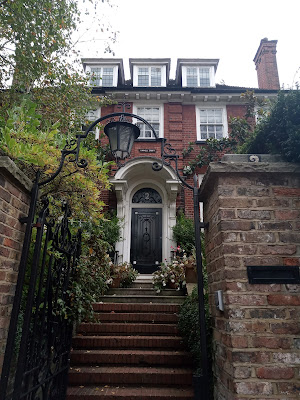London's lost rivers don't lie that deep - over the summer the Beverley rose high enough that cars could not get through. The Falcon regularly floods beneath the railway bridge in Clapham near the pub that bears it's name, and if you walk it's length - from Tooting to the Thames - there is more than one place where you can stand over a grating and hear it rush away below.
I know this because over the summer I 'did' a few of the South London rivers (The Effra and Falcon and Peck) following the routes in London's Lost Rivers by Tom Bolton (both volumes), as well as the Hogsmill, which is mostly above ground, and some confused wandering around the Graveney, a small tributary which feeds the Wandle, and has an irritating habit of being buried near the railway line or lost behind things like the Lidl car park. I'm sure there's a route with more river and less road though, and when I've worked it out will post it here.
The Wandle itself is, Bolton says, as much mislaid as lost. I've always known where bits of it were, Carshalton Ponds or the back of Plough Lane football ground or snug around Savacentre (as was) and Merton Abbey Mills, which used to be a mini Camden, but largely consists of restaurants now. I've fished dogs out of it and sat in the William Morris drinking next to it and walked from Waddon Ponds to where it enters the Thames at Wandsworth. Big efforts have been made to make a feature of the Wandle since I first became acquainted with it, and mostly they've been successful.
So I've been wondering, as a fan of Ben Aaronovitch's Rivers of London series, if or when the Wandle would make an appearance, and was pleased to see her turn up recently in Tales from the Folly, although I did feel, reading that book as a whole, that it was a completist sort of book - it would make a very poor introduction to the series. Or, to put it another way, I was very happy with it as a borrow from the library, but I don't feel any urge to own it.
I feel the same about What Abigail Did that Summer, also in the same series, but that's for completely different reasons. The book is clearly either written for children or so children can read it, and would be a grand introduction for a child of about eleven up.
As those who read the main stories will know, Abigail is Peter Grant's cousin (I don't think a first cousin, but extended family who live close by), and she's at that cusp between childhood and adulthood - in some ways very adult for her age, due to her home circumstances and the unavoidable awareness about how a young black girl is perceived, but in others very much an innocent still. She has the kind of freedom that comes with being old and wise enough to be allowed out alone and the less happy freedom of knowing your parents won't notice because they have more pressing things to worry about.
(It's significant, I think, that children's stories like The Lion the Witch and the Wardrobe, Bedknob(s) and Broomstick(s) and Carrie's War all begin with children evacuated to live with strangers.)
What really drew my attention though is that the book is set almost entirely on Hampstead Heath, which is a lovely backdrop for this kind of freedom, and creates a little world of it's own with set boundaries that can be mapped.
Which is why it was the catalyst for my finally walking the three lost London rivers that run down from Hampstead to the Thames (using the Bolton books again).
Westbourne, Tyburn and Fleet are good walks for late autumn. You begin on the hill in Hampstead Heath, which despite the simmering summer heat in Aaronovitch's book has always seemed to me an autumn sort of place: hot coffee and muddy dogs and golden turning leaves, and then by the time evening comes early you're in Holborn or Victoria or Marylebone, well lit and well populated.












No comments:
Post a Comment